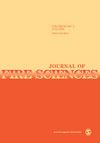Simulation of the burning and dripping cables in fire using the particle finite element method
IF 1.9
4区 工程技术
Q2 ENGINEERING, MULTIDISCIPLINARY
引用次数: 4
Abstract
The behavior of the cable jacket in fire characterized by the tendency to melt and drip constitutes a major source of fire hazard. The reason is that the melted material may convey the flame from one point to another, expanding fire and contributing to the fire load. In this article, the capability of a new computational strategy based on the particle finite element method for simulating a bench-scale cables burning test is analyzed. The use bench-scale test has been previously used to simulate the full-scale test described in EN 50399. As the air effect is neglected, a simple combustion model is included. The samples selected are two cables consisting of a copper core and differently flame retarded thermoplastic polyurethane sheets. The key modeling parameters were determined from different literature sources as well as experimentally. During the experiment, the specimen was burned under the test set-up condition recording the process and measuring the temperature evolution by means of three thermocouples. Next, the test was reproduced numerically and compared with a real fire test. The numerical results show that the particle finite element method can accurately predict the evolution of the temperature and the melting of the jacket.用颗粒有限元法模拟火灾中电缆的燃烧和滴水
电缆护套在火灾中具有熔化和滴水的特点,是火灾危险的主要来源。原因是熔化的材料可能会将火焰从一点传递到另一点,从而扩大火势并增加火灾负荷。本文分析了一种基于颗粒有限元法的模拟电缆燃烧试验的新计算策略的性能。使用试验台规模测试先前已用于模拟EN 50399中描述的全尺寸测试。由于忽略了空气的影响,采用了一个简单的燃烧模型。所选的样品是由铜芯和不同阻燃的热塑性聚氨酯片材组成的两条电缆。通过不同的文献资料和实验确定了关键的建模参数。在实验过程中,试样在测试设置条件下燃烧,记录燃烧过程,并通过三个热电偶测量温度演变。其次,对试验进行了数值再现,并与真实火灾试验进行了比较。数值计算结果表明,粒子有限元法可以准确地预测夹套的温度演变和熔化过程。
本文章由计算机程序翻译,如有差异,请以英文原文为准。
求助全文
约1分钟内获得全文
求助全文
来源期刊

Journal of Fire Sciences
工程技术-材料科学:综合
CiteScore
4.00
自引率
0.00%
发文量
14
审稿时长
2.5 months
期刊介绍:
The Journal of Fire Sciences is a leading journal for the reporting of significant fundamental and applied research that brings understanding of fire chemistry and fire physics to fire safety. Its content is aimed toward the prevention and mitigation of the adverse effects of fires involving combustible materials, as well as development of new tools to better address fire safety needs. The Journal of Fire Sciences covers experimental or theoretical studies of fire initiation and growth, flame retardant chemistry, fire physics relative to material behavior, fire containment, fire threat to people and the environment and fire safety engineering. This journal is a member of the Committee on Publication Ethics (COPE).
 求助内容:
求助内容: 应助结果提醒方式:
应助结果提醒方式:


